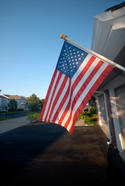It has been ten years since The Not So Big House became a surprise best seller, elevating a successful but unknown Minneapolis-based architect, Sarah Susanka, to the couch of Oprah Winfrey. Shortly after its release, the book became number one on Amazon.com, the force of which wasn’t fully understood or appreciated back in 1998. Since then she’s published five more books in the Not So Big series, but none have benefited as much from pitch-perfect timing. read more »
Suburbs
Beyond The Bailout: What’s Next in the Housing Market?
The Emergency Economic Stabilization Act of 2008 (we’ll call it the “Bail Out”) was signed into law on October 3rd. This, combined with the new reality in capital markets and current economic conditions, will result in some major shifts in the outlook for housing over the next few years. It is always possible that the federal government will try to do even more to fix what will be an agonizing housing problem over the next few years, but seems unlikely even Bernake, Paulson or their appointed successors will be able to change the basic story line. read more »
The Geography of Inequality
The global financial crisis has drawn greater attention to the world of the super rich and to the astounding increases in inequality since 1980, returning the country to a degree of inequality last seen in 1929 or perhaps even 1913. In the year 2006 alone, Wall Street executives received bonuses of $62 billion. Financial services increased from 10 percent of all business profits in 1980 to 40 percent in 2007, an obscene and indefensible development that now threatens the rest of the ‘real economy’.
Here’s what happened to income and wealth between 1970 and 2005 read more »
Sprawl is ubiquitous, even in my beloved Copenhagen
The year I attended the University of Copenhagen as an undergraduate, I lived in a suburb north of the city and commuted to the central city via bus and rail (the famous S-trains). What a great system, I remember thinking as an impressionable ingénue (you could go anywhere, and trains were on time to the second!). When I returned as a graduate student I lived right in the city center and discovered that great public transit did not obviate the need for extensive walking (I must have worn out five pairs of shoes that year). read more »
Neither fish nor fowl: Emerging urban enclaves in inner-ring suburbia
As I was walking my dog the other morning I was struck by the fact that the City of Falls Church, Virginia, the quaintly bucolic suburban “village” to which our family moved in mid-2001, was no longer suburban. It isn’t a city in the proper sense, like Washington, DC or even Alexandria, Virginia, but it is reflective of the trend towards quasi-urban places in the close-in rings – the original turn-of-the-century and pre-Levittown suburbs – enveloping our city cores. read more »
Bubble Opportunity: A New Life for Public Housing?
The globalization of housing markets stood at the center of the vast, now unraveling, economic change of the past decade. The creation of new investment vehicles in the 90s diverted vast amounts of capital into housing markets around the world. The results were many and varied. Design features began to converge, with gated communities following shopping malls into cites in Latin America, China, Turkey and most other countries. Home prices began to rise, with The Economist even publishing a table of global house prices, indicating those with the most inflated costs read more »
- Login to post comments
The future of suburbs? Suburbs ARE the future
I entered the field of futures research in 1981. No, not futures – contracts to deliver a certain commodity at a certain price at a date certain (God, I wish I had) – futures research, as in scenarios, trends, strategic planning and market planning. Unfortunately the place was soon lousy with what I call “futurism”: extrapolations of the unsustainable to make the improbable look inevitable.
A current example: suburbs are doomed because of high energy prices (peak oil!), the housing bubble, the obsolescence of the internal combustion engine, and yes, global warming (and what hasn’t been blamed on global warming?). Besides, the urban renaissance is underway; people want to live in the city for the culture, food, music and hipness, don’tchaknow. read more »
The future of urban settlement? Look in the suburbs
Let’s look at general urban settlement and suburbia from a geographic and demographic, not a planning or ideological viewpoint. There’s really no point to the fruitless and unscientific harangues about how people ought to live or about allegedly better or poorer forms of settlement. read more »
Suburbs will decide the election
By Joel Kotkin and Mark Schill
Suburbs may not have cooked up the mortgage crisis, but they absorbed much of initial damage. Now that Wall Street and the big cities are also taking the fall, suburbanites might feel a bit better — but there’s still lots of room for anger out in the land of picket fences, decent schools and shopping malls. read more »
- Login to post comments
How Low Can House Prices Go?
There is much speculation among economists and others about how close we are to the bottom of the collapse of housing prices. This is, of course, an important question, and goes to the heart of the wisdom or folly of the proposed $700 billion government bailout of financial markets, which is a consequence of their own profligate lending practices. read more »






















